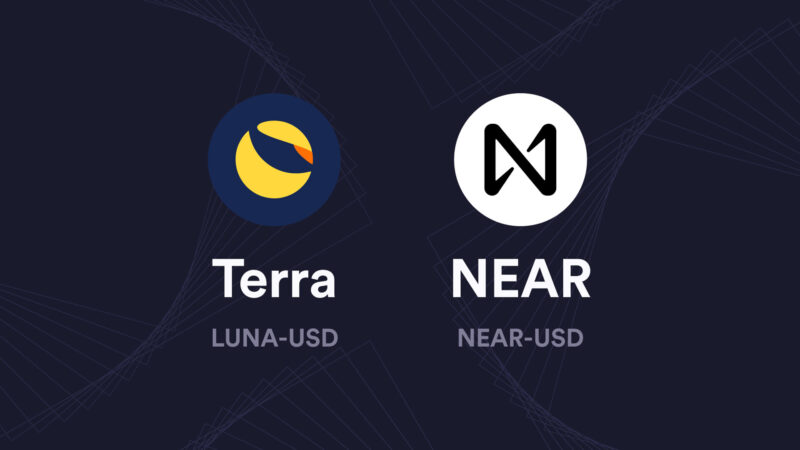The biggest question on my mind is “Is $NEAR the next $LUNA?”.
Near Protocol recently launched their own algorithmic stable coin which was inspired by LUNA and UST. When I first started on this article, I wanted to see if NEAR could rocket as much as LUNA did, but after that epic collapse. I also have to look at the flip side, whether or not NEAR could crash like LUNA.
In just a minute we’re going to dissect how NEAR and stable coin compares to LUNA/UST but first we got to start at the top and talk about how do they even work. Near Protocol is your typical layer one blockchain, it’s proof of stake. But one thing that’s special about them is that they have sharding. Fully implemented and live on their network whereas Ethereum is still years behind with their own starting implementation. Things are kind of early for NEAR though – because their main net launched in mid-2020. And right now, the total value locked in their ecosystem is less than one billion dollars.
You cannot talk about $NEAR without talking about Aurora. That’s their EVM compatible chain running on the Near Protocol, but it supports all the Ethereum Dapps out there. There’s a lot of stuff going on there but most recently all eyes have been on their new stable coin called USN. Initially it got a lot of buzz because it reminded people of UST and LUNA, back before it all collapsed. USN is an algo stable coin that’s native to Near Protocol, and it is soft pegged to one U.S. Dollar. They like to say it combines the growth potential of UST, with the peg defense of another algo stable coin called FRAX. Their whole goal with the stable coin is to increase the TVL (Total Value Locked) and liquidity in their own network, and also give more utility to their NEAR token.
Before we talk about how it stays stable, we got to ask why anyone would want USN? Because they get yield from holding it. Specifically, you get at least 11% APY. I say at least because that’s the APY you get from staking NEAR, and that is passed through to the holders of USN. You can get this yield through the various lending protocols in the Near ecosystem, but initially you should be able to get much higher APY like 20% or so, because the lending protocols themselves could add their own token incentives on top – That’s looking like some super juicy yield that rivals what other DeFi protocols offer.
Back to the million-dollar question – how does this all work to maintain stability for USN? Because the last thing we want is another LUNA/UST fiasco. There’re two main stability mechanisms at play, the on-chain swap, and the reserve fund. The on-chain swap is simple, it’s like the LUNA/UST swap. You send one dollar worth of NEAR to the smart contract, and it mints one USN for you. You can also send one USN to it and get one dollar worth of NEAR back. If the USN is trading for more or less than one dollar, you can do arbitrage by using outside exchanges and this on-chain swap to help bring the price back to one dollar. I’m not going to explain this too deeply because I already did that in my LUNA/UST article.
One gigantic difference to note is that the NEAR that people send to the swap contract does not get burned, instead it is staked on the Near blockchain to generate staking rewards. And that is what gets distributed to the USN holders for that 11% base yield. Also new NEAR is not minted if you send USN to the swap contract, it just gets returned to you from the pool. This is a huge difference compared to the LUNA/UST model, that mints or burns new LUNA as needed.
The second key piece to maintain stability is the reserve fund. This is kind of like the Bitcoin that Do Kwon bought to protect UST’s peg. But in this case, it was built into the system from the very beginning, to make sure there’s enough collateral available to defend the peg at all times.
Initially, this reserve fund is double collateralized with both NEAR and Tether USDT. Let’s say they want to have 1 billion USN initially, then the reserve fund would be filled with 1 billion dollars with NEAR, plus 1 billion USDT as well, so the initial collateralization ratio is 200%.
But as USN grows, they’re targeting in eventual 100% ratio in the future. This means that if there’s ever a panic sale of USN, they’d be able to buy back all the USN ever issued with their reserves.
Every time someone buys USN with either NEAR or some other stable coin, those get put into the reserve fund. As USN is minted or burned, the amount of NEAR or other stable coins increases or decreases within the reserve. But just how do they use this reserve fund to defend the peg? After all it is not a good idea to do it willy-nilly like Do Kwon did. But before we get there, we got to talk about Stableswaps because that’s another protocol that helps stabilize USN as well.
Stableswaps is the part of Ref Finance, an AMM DEX running on Near protocol. It’s actually kind of similar to Curve on Ethereum because they handle swaps of similar types of assets. They’re going to have a USN to USDT pool on there, and that’s a good thing because if there’s a lot of liquidity there, it will help stabilize the price of USN more. The initial USN put into that pool will be filled by Near Protocol itself, and whenever someone swaps their USDT for USN, their USDT is added to the pool.
Everything is managed by smart contract, which mints or withdrawals USN from the pool to make sure things stay balanced there. How do all these pieces come together to defend the peg? Well, they have a set of processes called “Treasury Management” and the whole idea is to use the NEAR and USDT that they have to keep things balanced. So, the fund buys NEAR with the stable coins to support the NEAR USD price when it is dropping, and it sells NEAR for stable coins when the NEAR USD price is rising. The NEAR USD price is super important here because if it gets too low, then you may run into the catastrophic situation, where there’s more USN out there than there is NEAR available to give back to people through that on-chain swap.
So they need things to be balanced, and they use their treasury management plus arbitrage to do that. Just to spell things out for you, more NEAR is added to the reserve fund under two scenarios, when people swap their NEAR for USN using that on-chain swap, and when the fund sells USDT for NEAR to do some rebalancing or other market interventions.
Similarly, more USDT is added to the reserve fund under two scenarios, when people swap their USDT for USN on Stableswaps, and when the reserve fund sells their NEAR for USDT to keep things balanced.
This has been a ton of details, but you probably want to know if this is going to cause a death spiral like LUNA/UST did. This is the scenario where people mint a lot of USN while NEAR’s price is steady, but then for whatever reason the price of NEAR crashes real fast, and now the market cap of USN is greater than the market cap of NEAR, this would be disastrous. Because if you send all the existing USN to the on-chain swap, you would not be able to get the dollar amount of NEAR that you were promised. People would see that, they would lose confidence and then both NEAR and USN would get dumped like crazy, just like we saw with LUNA/UST.
The team says that this scenario is not likely to happen because they have the reserve fund and treasury management to support the system. They say they ran a bunch of simulations with historical price data which makes them confident that their process will work. Remember, their plan is to use their USDT to buy NEAR, if the price of NEAR drops to dangerously low levels.
But I don’t really know if that’s going to work because think about it, the amount of liquidity out there matters. If the order books are thin for NEAR, they may have enough NEAR to cover all their USN liabilities, on paper. But if anyone went to go dump more of it, the team would be screwed, and they would not have enough ammo to defend the peg.
so I don’t really feel safe even though they say that all USN emitted is covered by NEAR plus other stable coins. I’d feel way safer if they kept a higher collateralization ratio with a diverse set of stable coins, and not just 100% ratio with NEAR plus USDT because I don’t trust the NEAR part of that equation. NEAR could drop hard and leave things under collateralized hence kicking off a bank run.
But here’s the thing, NEAR in USN isn’t quite as risky as LUNA/UST either for three key reasons. First, they don’t have something as ponzi-like and unsustainable as Anchor Protocol. UST grew so fast because Anchor Protocol was offering a crazy 20% yield, but that was completely funded by external deposits, so it was never sustainable. On the other hand, USN’s floor APY of 11% comes from staking the NEAR in the reserve fund so that’s always going to be there and it’s sustainable, too.
Second, there’s significantly higher collateralization ratio for USN, and the collateral is built into the system, so that makes it much safer than UST. Just look at FRAX, which is a stable coin that USN is based on, that has been around for a couple years now and has held its peg surprisingly well. So that gives me a little more faith for USN.
Third, the hyper-inflation scenario that happened to LUNA is not possible here, because the on-chain swap does not mint new NEAR when you send in USN. So even if a bank run did happen, you’re never going to get a trillion NEAR printed, which is what happened to LUNA.
But wait, because there’s actually two reasons that make me bullish on NEAR in the short to midterm. First, USN helps reduce selling pressure on NEAR. Think about it, if someone wants to sell their NEAR for USDT, they could do that directly on a DEX, but that’s not a good idea because it would incur higher slippage. Instead, they could swap it for USN first, and then trade that to USDT through Stableswaps for much less slippage. And with this method the NEAR would be staked, instead of sold on the open market. So that’s selling pressure that would disappear.
The second reason to be bullish is that there’s a lot of NEAR already state, and by offering this new yield generating stable coin, this could cost even more NEAR to be bought up in state. This means less NEAR is available to be dumped on the market, and this is also a new source of market demand.
After all they are going to be offering much higher yield than just 11%, If they add all the token incentives layered on top. So my personal take is, long NEAR and maybe have some USN too. But don’t get too crazy with it, it is not a set and forget after all. You got to keep an eye on how the USN market cap, and the reserve fund balances change over time. Fortunately, USN is still small right now so as long as it’s not a bubble. Thing should be okay.




